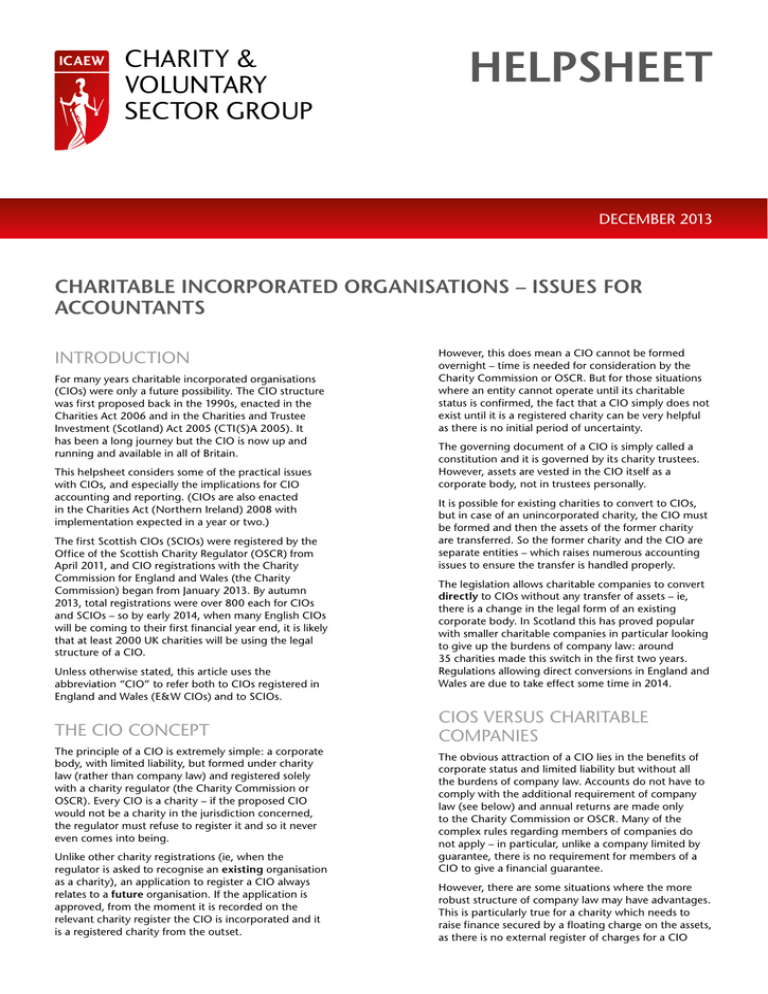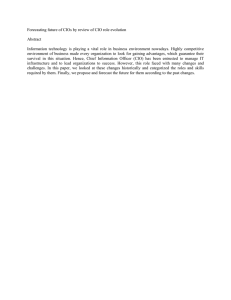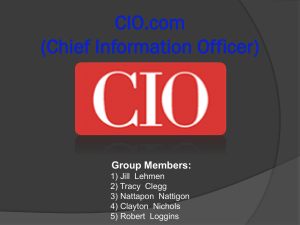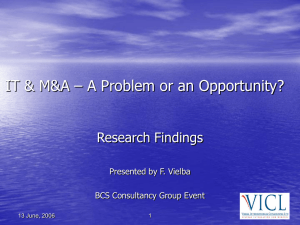
ICAEW
CHARITY &
VOLUNTARY
SECTOR GROUP
HELPSHEET
December 2013
CHARITABLE INCORPORATED ORGANISATIONS – ISSUES FOR
ACCOUNTANTS
INTRODUCTION
For many years charitable incorporated organisations
(CIOs) were only a future possibility. The CIO structure
was first proposed back in the 1990s, enacted in the
Charities Act 2006 and in the Charities and Trustee
Investment (Scotland) Act 2005 (CTI(S)A 2005). It
has been a long journey but the CIO is now up and
running and available in all of Britain.
This helpsheet considers some of the practical issues
with CIOs, and especially the implications for CIO
accounting and reporting. (CIOs are also enacted
in the Charities Act (Northern Ireland) 2008 with
implementation expected in a year or two.)
The first Scottish CIOs (SCIOs) were registered by the
Office of the Scottish Charity Regulator (OSCR) from
April 2011, and CIO registrations with the Charity
Commission for England and Wales (the Charity
Commission) began from January 2013. By autumn
2013, total registrations were over 800 each for CIOs
and SCIOs – so by early 2014, when many English CIOs
will be coming to their first financial year end, it is likely
that at least 2000 UK charities will be using the legal
structure of a CIO.
Unless otherwise stated, this article uses the
abbreviation “CIO” to refer both to CIOs registered in
England and Wales (E&W CIOs) and to SCIOs.
THE CIO CONCEPT
The principle of a CIO is extremely simple: a corporate
body, with limited liability, but formed under charity
law (rather than company law) and registered solely
with a charity regulator (the Charity Commission or
OSCR). Every CIO is a charity – if the proposed CIO
would not be a charity in the jurisdiction concerned,
the regulator must refuse to register it and so it never
even comes into being.
Unlike other charity registrations (ie, when the
regulator is asked to recognise an existing organisation
as a charity), an application to register a CIO always
relates to a future organisation. If the application is
approved, from the moment it is recorded on the
relevant charity register the CIO is incorporated and it
is a registered charity from the outset.
However, this does mean a CIO cannot be formed
overnight – time is needed for consideration by the
Charity Commission or OSCR. But for those situations
where an entity cannot operate until its charitable
status is confirmed, the fact that a CIO simply does not
exist until it is a registered charity can be very helpful
as there is no initial period of uncertainty.
The governing document of a CIO is simply called a
constitution and it is governed by its charity trustees.
However, assets are vested in the CIO itself as a
corporate body, not in trustees personally.
It is possible for existing charities to convert to CIOs,
but in case of an unincorporated charity, the CIO must
be formed and then the assets of the former charity
are transferred. So the former charity and the CIO are
separate entities – which raises numerous accounting
issues to ensure the transfer is handled properly.
The legislation allows charitable companies to convert
directly to CIOs without any transfer of assets – ie,
there is a change in the legal form of an existing
corporate body. In Scotland this has proved popular
with smaller charitable companies in particular looking
to give up the burdens of company law: around
35 charities made this switch in the first two years.
Regulations allowing direct conversions in England and
Wales are due to take effect some time in 2014.
CIOS VERSUS CHARITABLE
COMPANIES
The obvious attraction of a CIO lies in the benefits of
corporate status and limited liability but without all
the burdens of company law. Accounts do not have to
comply with the additional requirement of company
law (see below) and annual returns are made only
to the Charity Commission or OSCR. Many of the
complex rules regarding members of companies do
not apply – in particular, unlike a company limited by
guarantee, there is no requirement for members of a
CIO to give a financial guarantee.
However, there are some situations where the more
robust structure of company law may have advantages.
This is particularly true for a charity which needs to
raise finance secured by a floating charge on the assets,
as there is no external register of charges for a CIO
(although across the charity sector as a whole, floating charges are rare). Subject to the normal provisions of charity law, there is
nothing to stop a CIO raising a mortgage secured on freehold property, as the lender will have the protection of a charge registered
against the land.
Some have suggested that charitable companies are more appropriate than CIOs for larger charities with substantial commitments,
and clearly at the larger end the burdens of complying with company law are proportionately less demanding. However, in Scotland
some former public sector bodies have become charities as SCIOs with income up to £10M, so size is certainly not a barrier.
INSOLVENCY
As a corporate body with limited liability, there is always a possibility of a CIO becoming insolvent, so going concern issues are
central. In England and Wales a CIO insolvency follows essentially the same procedures as a company insolvency with all of the
options available in the Insolvency Act 1986. In Scotland a SCIO insolvency is treated more like a personal bankruptcy.
ACCOUNTING AND REPORTING
Because a CIO is not a company, the accounting and reporting requirements follow charity law rather than company law. In
particular, this means smaller CIOs are free to prepare their accounts on the receipts and payments basis: unlike charitable companies
they are not obliged to use the accruals basis and apply the Charities SORP if the income is below £250,000.
The trustees’ report and accounts are prepared and scrutinised under ss132–166, Charities Act 2011 (CA 2011) for an E&W CIO, and
under s44, CTI(S)A 2005 for a SCIO. This means that the financial thresholds operate as shown in the following table. (Please note
that this table shows the minimum requirements by law at each level: it does not consider additional requirements from funders or
trustees or accounting requirements written into the CIO’s constitution).
THRESHOLDS FOR ACCOUNTING AND REPORTING REQUIREMENTS FOR E&W CIOS AND SCIOS
Income
Minimum rules for presentation of accounts
Minimum rules for external scrutiny of accounts*
E&W CIOs
SCIOs
E&W CIOs
SCIOs
Up to £25,000
Receipts and payments
account with a
statement of assets and
liabilities
Receipts and payments
account with a
statement of balances
Approval by trustees
only – no external
scrutiny required
Independent
examination (lay
examiner if accounts on
receipts and payments
basis)
£25,000 to £250,000
Receipts and payments
account with a
statement of assets and
liabilities
Receipts and payments
account with a
statement of balances
Independent
examination (lay
examiner)
Independent
examination (lay
examiner if accounts on
receipts and payments
basis)
£250,000 to £500,000
Accruals basis following
Charities SORP
2005 (but can use
simplifications in SORP
Appendix 5)
Accruals basis following
Charities SORP
2005 (but can use
simplifications in SORP
Appendix 5)
Independent
examination
(professionally qualified
examiner)*
Independent
examination
(professionally qualified
examiner)*
Over £500,000
Accruals basis following
SORP in full
Accruals basis following
SORP in full
Audit
Audit
*An audit is required in this band if the CIO has over £3.26m assets
Note than an E&W CIO could also be registered with OSCR (as a cross-border charity) if the charity has significant activities in
Scotland. In such cases both sets of requirements must be followed.
As with other charities, the trustees of a CIO are free to choose any year end which suits the charity’s work, subject to compliance
with Charities (Accounts and Reports) Regulation 2008 for E&W CIOs or the Charities Accounts (Scotland) Regulation 2006 (as
amended) for SCIOs. There is no equivalent of the “accounting reference date” for companies.
The first financial year of a new CIO will often be for a period which is not exactly 12 months. This is because it must start from the
date on which the CIO was formed. However, the regulations require that an accounting period must be not less than 6 months and
not more than 18 months. So where a CIO is formed a long time before it starts work, it may be necessary to prepare accounts where
all figures are nil until work begins.
For example, consider a CIO which is registered on 24 July 2013, receives its first funds on 1 April 2014 and prepares accounts to a 31
March year end. The first accounts cannot run from 24 July 2013 to 31 March 2015 because that is more than 18 months. So it will
be necessary to prepare an initial set of accounts with nil figures that cover just over 8 months: from 24 July 2013 to 31 March 2014.
Then the first active accounts will cover the 12 months from 1 April 2014 to 31 March 2015.
These should not, however, be described as “dormant
accounts” because the legal concept of dormant
accounts only applies under company law. If a CIO has
an accounting period in which all the figures are nil,
accounts should still be produced in the normal way,
showing the nil figures, and a trustees’ report is still
needed. In particular, the report will need to explain
what plans the trustees are making for the future to
advance the charity’s purposes for public benefit.
Where an E&W CIO uses the receipts and payments
basis for its accounts, the regulations require certain
specific disclosures by way of notes to the accounts.
These must be added to the statement of assets and
liabilities, under the CIO General Regulations 2012,
reg 62 (normally, no specific notes are need for receipts
and payments accounts of charities in England and
Wales). This is an additional requirement to protect
third parties dealing with CIOs.
The notes to the statement of assets and liabilities
must:
• Include particulars of any guarantee given by the
CIO (if still in force at year end). For instance, if the
CIO has: agreed to underwrite the costs of an event
or project run by another organisation; underwritten
a commitment on behalf of a beneficiary; or given a
guarantee to the trustees of a former unincorporated
charity.
• Disclose any debt outstanding at year end which
is a secured charge on an asset of the CIO. For
example, if the CIO has a property with a mortgage
outstanding, or in the rare event that the CIO has a
floating charge.
AUDIT AND INDEPENDENT
EXAMINATION
The principles involved in the audit or independent
examination of the accounts of a CIO are similar
to those with other charities, but the auditor or
independent examiner (IE) needs constantly to bear in
mind that accounts relate to an incorporated charity
which is not a company.
In the case of CIOs which have been established to
take over work from a former unincorporated charity,
care is needed to ensure that all assets have been
properly transferred (if not, separate accounts may be
needed for the old charity and the CIO). The auditor
or IE needs to review the transfer agreement or vesting
agreement under which the assets were transferred and
make sure all its provisions have been implemented.
Funding awarded to a former charity cannot be
transferred to the CIO without the consent of the
funder, so such agreements need to be reviewed and
the accounts may need adjusting if the CIO accounts
recognise income where there are doubts regarding
entitlement. If, as is often the case, the CIO has given
any guarantees to former trustees or taken on any
liabilities, these must be properly disclosed if the report
is to be unqualified.
In a CIO, the requirement to keep accounting records,
and the report of the auditor or IE is under the CA 2011
or CTI(S)A 2005 – there should be no references to
company law in the audit/IE report, nor on the balance
sheet or anywhere else.
A well-prepared statement of assets and liabilities for
any charity using receipts and payments accounts
should include these disclosures if applicable, so these
are not necessarily extra requirements for a CIO.
However, if they are omitted, readers may wonder
if they have simply been overlooked. So if neither of
these disclosures are needed, it could help to add a
note saying: “The trustees confirm, in accordance with
the Charitable Incorporated Organisations (General)
Regulations 2012, that at year end the CIO did not
have any outstanding guarantees to third parties nor
any debts secured on assets of the CIO.”
OVERALL
FILING OF ACCOUNTS
Charitable Incorporated Organisations
1st edition, 2013
Gareth G Morgan
ISBN 978 1 906294 26 7
An important requirement for E&W CIOs is that the
annual report and accounts must always be filed with
the Charity Commission (by 10 months after year
end at the latest): unlike other registered charities in
England and Wales, there is no exemption for those up
to £25,000 income. SCIOs, like all Scottish charities,
must file their signed accounts with OSCR by 9 months
after year end.
Charity & Voluntary Sector Group
E sigs@icaew.com
icaew.com/charity
After many years of uncertainty, an increasing number
of charities are using the CIO form. Accountants and
others working with charities need to be fully familiar
with the principles – and in particular the significant
differences between E&W CIOs and SCIOs. But in most
cases, the simplicity of the CIO and the associated
accounting framework will be a breath of fresh air
compared to the complexity of charitable companies.
FURTHER READING
Published by Directory of Social Change
dsc.org.uk
We gratefully acknowledge the contribution of Gareth G Morgan, Professor of Charity Studies at Sheffield
Hallam University, who wrote this helpsheet. © ICAEW 2013. All rights reserved. If you want to reproduce or redistribute any of the material in this publication, you should
first get ICAEW’s permission in writing.
ICAEW will not be liable for any reliance you place on the information in this material. You should seek
independent advice.
Laws and regulations referred to in this ICAEW helpsheet are stated as at November 2013. All points in this
document are covered at an overview level only: it is not a full statement of the law.
© ICAEW 2013. MSDDIG12753 12/13



